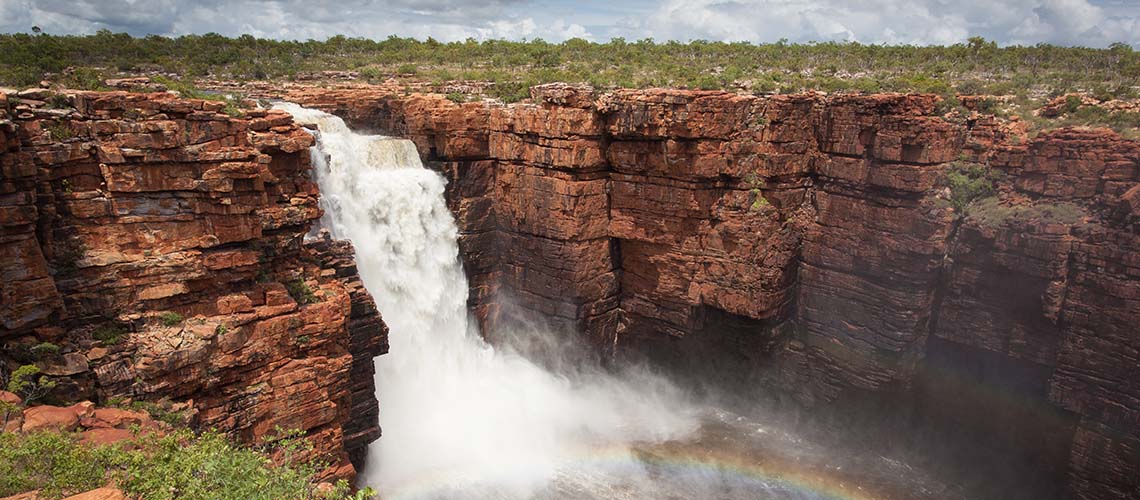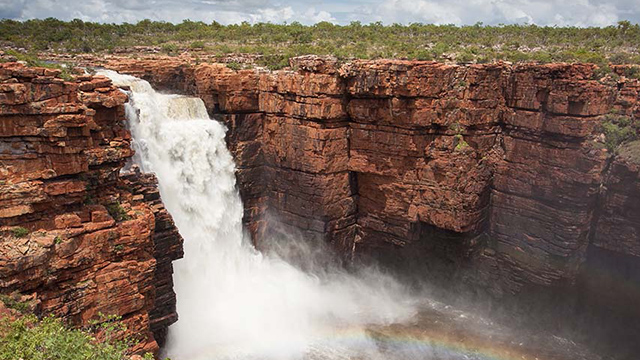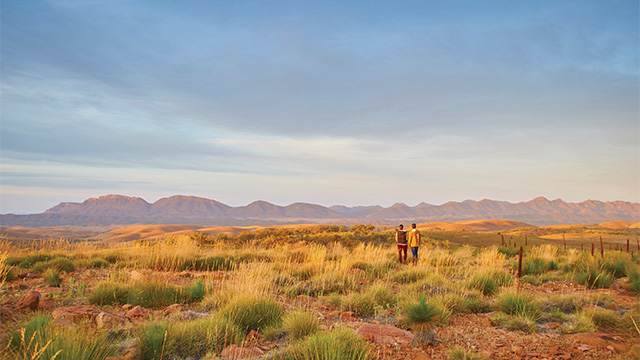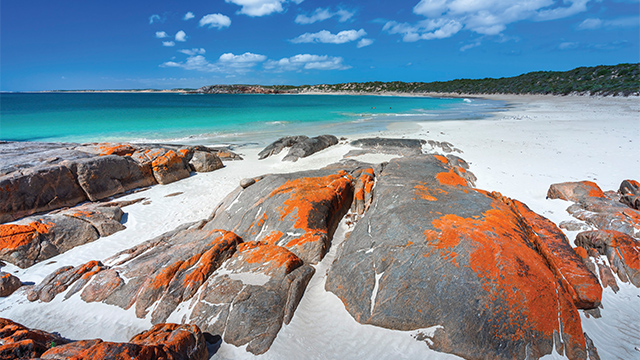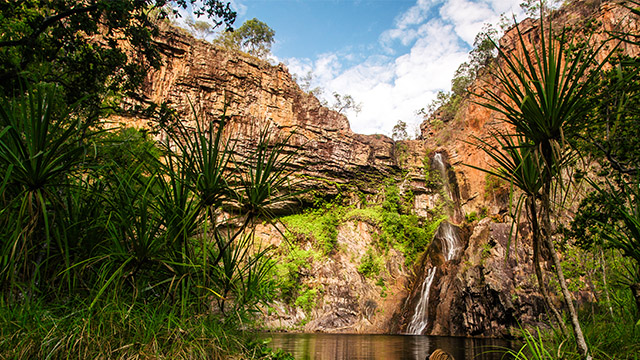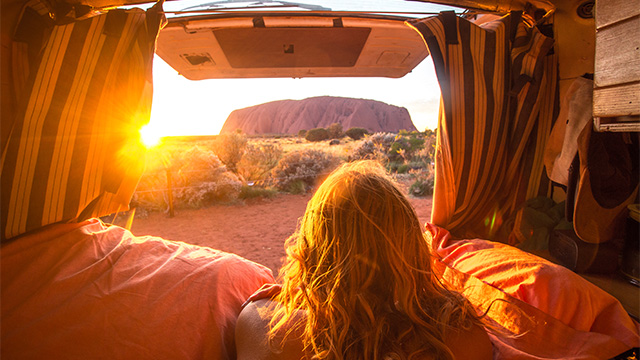Discover the Kimberley in WA
The experience: Explore remote wilderness
The location: The Kimberley, WA
Why go: Western Australia’s Kimberley region offers up wild, ancient landscapes and life-changing experiences in equal measure. Spread over hundreds of thousands of kilometres in Australia’s northwest corner, the Kimberley is so vast that you could fit the state of Victoria in it – almost twice. The region’s spectacular scenery owes much to its geography, hemmed in by an impenetrable coastline and the Great Sandy and Tanami deserts of the Pilbara. It’s a jaw-dropping union of palm-fringed sandstone gorges and steep ridges, thundering waterfalls and desolate mountains. Some of the world’s most dangerous creatures live here – including huge saltwater crocodiles – but also some of its most precious, such as the channel-billed cuckoo and the tree frog. The Aboriginal culture dates back more than 40,000 years and there are still traces of this ancient history in the rock art across the region. The major gateway to the Kimberley is Broome, more than 2,200 kilometres north of Perth and famous for its 22-kilometre stretch of sand, Cable Beach.
Where to stay: In Broome, Cable Beach Club is the ultimate destination for sundowners. The rooms include three themed suites dedicated to Australian artists.
Getting there: There are flights to Perth from major capital cities. From there, it’s a 2.5-hour flight north to Broome.
Discover Australia’s South West region in WA
The experience: Walk among giants
The location: Australia’s South West, WA
Why go: From Margaret River to Manjimup, Australia’s South West turns it on when it comes to impressive culinary experiences. In the former destination, you’ll find some of the country’s most applauded wineries – Leeuwin Estate, Vasse Felix and Cape Mentelle among them – not to mention world-class waves. An annual truffle festival sees thousands of people turn up to savour the earthy delicacy, but this region is much more than good food and wine. In the Southern Forests, be dwarfed by enormous karri trees, some more than 300 years old. Come spring, the landscape is transformed with the world’s largest collection of wildflowers. Equally impressive are the ancient red tingle trees in the Walpole-Nornalup National Park, where a walkway 40 metres above the ground offers a bird’s-eye view of the forest, much of it unique to this pocket of the planet.
Where to stay: There are only six villas at Losari Retreat, set across 27 hectares of landscaped gardens. Open fires and private spa baths are just some of the niceties.
Getting there: There are flights to Perth from major Australian capital cities. If you’re self-driving, rent a SIXT car at the airport and enjoy the 275-kilometre road trip south to the Margaret River.
Why QLD's Great Barrier Reef is not to be missed
The experience: Snorkel the world’s largest reef
The location: Great Barrier Reef, QLD
Why go: The Great Barrier Reef stretches 2,300 kilometres along Australia’s east coast in the Coral Sea. The World Heritage Site is actually composed of some 2,900 individual reefs, 900 islands and is the world’s biggest structure made by living organisms. One of the best ways to take it all in is with your head underwater. The marine biodiversity is staggering – from the animals, plants and algae to microorganisms too small to see. Snorkelling, diving or in glass-bottom boats you’ll have the chance to see some of the reef’s 1,600 species of fish, six of the world’s seven species of marine turtles, 30 species of whales and dolphins and one of the world’s most important dugong populations. When you surface for air, you can gaze up at more than 200 species of birds.
Where to stay: The Coral Sea surrounds you when you check in to one of the rooms at exclusive Qualia on Hamilton Island in the Whitsundays. Villas come with private pools, but you should really spend any time in the water exploring the reef.
Getting there: There are flights to Hamilton Island from Sydney, Melbourne and Brisbane.
Discover the rugged beauty of Kangaroo Island, SA
The experience: Get up close and personal with native fauna
The location: Kangaroo Island, SA
Why go: While it takes its name from one of Australia’s most common marsupials, Kangaroo Island is actually better known for some of its other fauna. You’re guaranteed to see rare birds, tammar wallabies, short-beaked echidnas and lots of koalas. During the cooler months you can watch migrating southern right whales as well. True to its name, Seal Bay is the breeding ground for one of Australia’s largest colonies of sea lions, with the endangered animals unique to South and Western Australia. This is one of the few places in the world you can witness sea lions at such close proximity, with guided tours taking you along boardwalks through the dunes. Another animal encounter can be enjoyed at Admirals Arch, a remnant of an ancient cave that is now home to a large colony of New Zealand fur seals. It’s part of Flinders Chase National Park, which is also home to the Remarkable Rocks – it took 500 million years for rain, wind and pounding waves to create these granite boulders.
Where to stay: Sweeping along rugged cliffs on the island’s south coast, Southern Ocean Lodge impresses from the moment you step into the lobby, its floor-to-ceiling windows framing the wild ocean beyond.
Getting there: There are flights to Adelaide from major Australian cities. From there you can either catch a 30-minute flight south to the island, or hire a SIXT car (why not choose an EV!) and take it across on a daily ferry linking the island with the mainland.







